NVIDIA GeForce GTX 690 Review: Ultra Expensive, Ultra Rare, Ultra Fast
by Ryan Smith on May 3, 2012 9:00 AM ESTOverclocked: Power, Temperature, & Noise
Our final task is our look at GTX 690’s overclocking capabilities. NVIDIA has told us that with GTX 690 they weren’t just looking to duplicate GTX 680 SLI’s performance, but also its overclocking capabilities. This is quite the lofty goal, since with GTX 690 NVIDIA is effectively packing 2 680s into the same amount of space, leaving far less space for VRM circuitry and trace routing.
| GeForce 600 Series Overclocking | ||||
| GTX 690 | GTX 680 | |||
| Shipping Core Clock | 915MHz | 1006MHz | ||
| Shipping Max Boost Clock | 1058MHz | 1110MHz | ||
| Shipping Memory Clock | 6GHz | 6GHz | ||
| Shipping Max Boost Voltage | 1.175v | 1.175v | ||
| Overclock Core Clock | 1040MHz | 1106MHz | ||
| Overclock Max Boost Clock | 1183MHz | 1210MHz | ||
| Overclock Memory Clock | 7GHz | 6.5GHz | ||
| Overclock Max Boost Voltage | 1.175v | 1.175v | ||
In practice NVIDIA has not quite kept up with GTX 680, and in other ways completely exceeded it. When it comes to the core clock we didn’t quite reach parity with our reference GTX 680; the GTX 680’s highest boost clock bin could hit 1210MHz, while the GTX 690’s highest boost clock bin topped out at 1183MHz, some 27MHz (2%) slower.
On the other hand, our memory overclock is so high as to be within the “this doesn’t seem physically possible” range. As we have discussed time and time again, GDDR5 memory busses are difficult to run at high clocks on a good day, never mind a bad day. With GF110 NVIDIA couldn’t get too far past 4GHz, and even with GTX 680 NVIDIA was only shipping at 6GHz.
It would appear that no one has told NVIDIA’s engineers that 7GHz is supposed to be impossible, and as a result they’ve gone and done the unthinkable. Some of this is certainly down to the luck of the draw, but it doesn’t change the fact that our GTX 690 passed every last stability test we could throw at it at 7GHz. And what makes this particularly interesting is the difference between the GTX 680 and the GTX 690 – both are equipped with 6GHz GDDR5 RAM, but while the GTX 680 is equipped with Hynix the GTX 690 is equipped with Samsung. Perhaps the key to all of this is the Samsung RAM?
In any case, our final result was a +125MHz core clock offset and a +1000MHz memory clock offset, which translates into a base clock of 1040MHz, a max boost clock of 1183MHz, and a memory clock of 7GHz. This represents a 12%-14% core overclock and a 17% memory overclock, which is going to be enough to put quite the pep in the GTX 690’s step.
As always we’re going to start our look at overclocking in reverse, beginning with power, temperature, and noise. For the purpose of our testing we’ve tested our GTX 690 at two different settings: at stock clocks with the power target set to 135% (GTX 690 PT), and with our custom overclock alongside the same 135% power target (GTX 690 OC). This allows us to look at both full overclocking and the safer option of merely maxing out the boost clocks for all they’re worth.
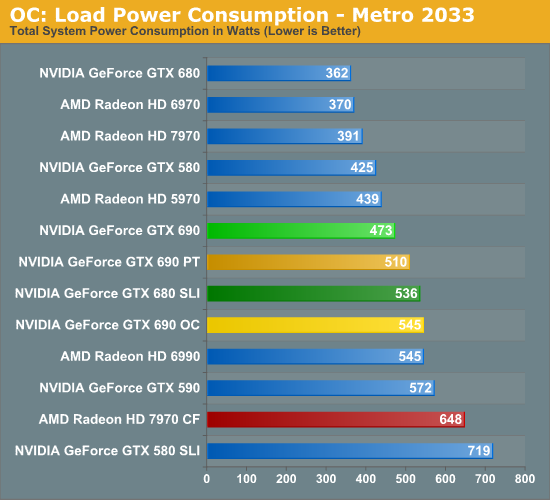

As expected, merely increasing the power target to 135% was enough to increase the GTX 690’s power consumption, though overclocking further adds to that. Even with the power target increase however, the power consumption at the wall for the GTX 690 is still lower than the GTX 680 SLI by over 20W, which is quite impressive. As we’ll see in our section on performance this is more than enough to erase the GTX 690’s performance gap, meaning at this point its still consuming less power than the GTX 680 SLI while offering better performance than its dual-card cousin.
It’s only after outright overclocking that we finally see power consumption equalize with the GTX 680 SLI. The overclocked GTX 690 is within 10W of the GTX 680 SLI, though as we’ll see the performance is notably higher.
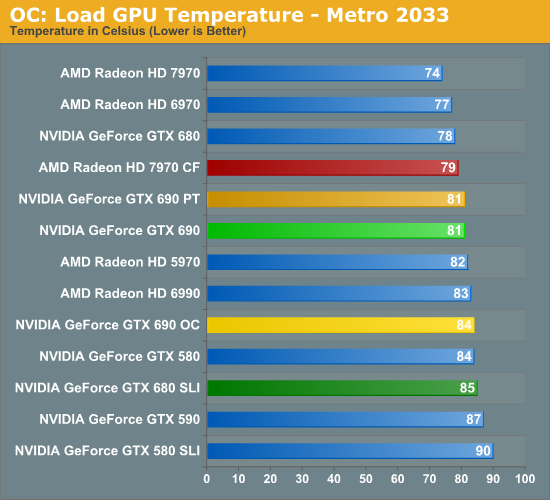
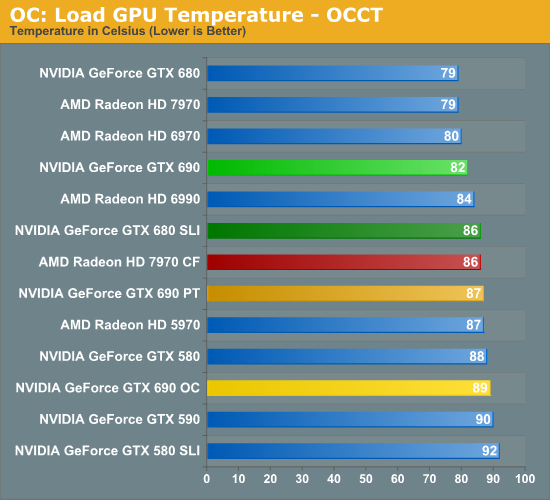
What does playing with clocks and the power target do to temperatures? The impact isn’t particularly bad, though we’re definitely reaching the highest temperatures we really want to hit. For the GTX 690 PT things are actually quite good under Metro, with the temperature not budging an inch even with the higher power consumption. Under OCCT however temperatures have risen 5C to 87C. Meanwhile the GTX 690 OC reaches 84C under Metro and a toasty 89C under Metro. These should be safe temperatures, but I would not want to cross 90C for any extended period of time.
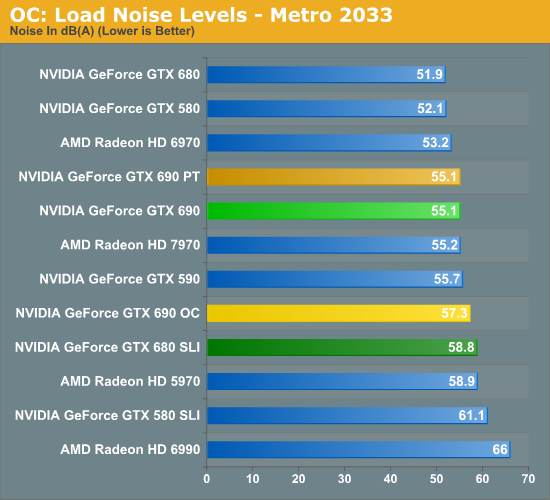
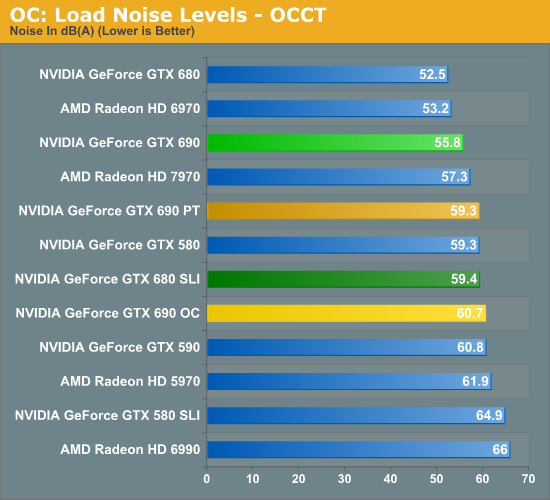
Finally we have load noise. Unsurprisingly, because load temperatures did not go up for the GTX 690 PT under Metro load noise has not gone up either. On the other hand load noise under OCCT has gone up 3.5dB, making the GTX 690 PT just as loud as our GTX 680 SLI in its adjacent configuration. In practice the noise impact from raising the power target is going trend closer to Metro than OCCT, but Metro is likely an overly optimistic scenario; there’s going to be at least a small increase in noise here.
The GTX 690 OC meanwhile approaches the noise level of the GTX 680 SLI under Metro, and shoots past it under OCCT. Considering the performance payoff some users will no doubt find this worth the noise, but it should be clear that overclocking like this means sacrificing the stock GTX 690’s quietness.










200 Comments
View All Comments
CeriseCogburn - Thursday, May 10, 2012 - link
The GTX680 by EVGA in a single sku outsells the combined total sales of the 7870 and 7850 at newegg.nVidia "vaporware" sells more units than the proclaimed "best deal" 7000 series amd cards.
ROFL
Thanks for not noticing.
Invincible10001 - Sunday, May 13, 2012 - link
Maybe a noob question, but can we expect a mobile version of the 690 on laptops anytime soon?trumpetlicks - Thursday, May 24, 2012 - link
Compute performance in this case may have to do with 2 things:- Amount of memory available for the threaded computational algorithm being run, and
- the memory IO throughput capability.
From the rumor-mill, the next NVidia chip may contain 4 GB per chip and a 512 bit bus (which is 2x larger than the GK104).
If you can't feed the beast as fast as it can eat it, then adding more cores won't increase your overall performance.
Joseph Gubbels - Tuesday, May 29, 2012 - link
I am a new reader and equally new to the subject matter, so sorry if this is a dumb question. The second page mentioned that NVIDIA will be limiting its partners' branding of the cards, and that the first generation of GTX 690 cards are reference boards. Does NVIDIA just make a reference design that other companies use to make their own graphics cards? If not, then why would anyone but NVIDIA have any branding on the cards?Dark0tricks - Saturday, June 2, 2012 - link
anyone who sides with AMD or NVIDIA are retards - side with yourself as a consumer - buy the best card at the time that is available AND right for your NEEDs.fact is the the 690 is trash regardless of whether you are comparing it to a NVIDIA card to a AMD card - if im buying a card like a 690 why the FUCK would i want anything below 1200 P
even if it is uncommon its a mfing trash of a $1000 card considering:
$999 GeForce GTX 690
$499 GeForce GTX 680
$479 Radeon HD 7970
and that SLI and CF both beat(or equal) the 690 at higher res's and cost less(by 1$ for NVIDIA but still like srsly wtf NVIDIA !? and 40$ for AMD) ... WHAT !?
furthermore you guys fighting over bias when the WHOLE mfing GFX community (companies, software developers is built on bias) is utterly ridiculous, GFX vendoers (AMD and NVIDA) have skewed results for games for the last decade + , and software vendors two - there needs to laws against specfically building a software for a particular graphics card in addition to making the software work worse on the other (this applies to both companies)
hell workstation graphics cards are a very good example of how the industry likes to screw over consumers ( if u ever bios modded - not just soft modded a normal consumer card to a work station card , you would know all that extra charge(up-to 70% extra for the same processor) of a workstation card is BS and if the government cleaned up their shitty policies we the consumer would be better for it)
nyran125 - Monday, June 4, 2012 - link
yep........Ultra expensive and Ultra pointless.
kitty4427 - Monday, August 20, 2012 - link
I can't seem to find anything suggesting that the beta has started...trameaa - Friday, March 1, 2013 - link
I know this is a really old review, and everyone has long since stopped the discussion - but I just couldn't resist posting something after reading through all the comments. Understand, I mean no disrespect to anyone at all by saying this, but it really does seem like a lot of people haven't actually used these cards first hand.I see all this discussion of nVidia surround type setups with massive resolutions and it makes me laugh a little. The 690 is obviously an amazing graphics card. I don't have one, but I do use 2x680 in SLI and have for some time now.
As a general rule, these cards have nowhere near the processing power necessary to run those gigantic screen resolutions with all the settings cranked up to maximum detail, 8xAA, 16xAF, tessellation, etc....
In fact, my 680 SLI setup can easily be running as low as 35 fps in a game like Metro 2033 with every setting turned up to max - and that is at 1920x1080.
So, for all those people that think buying a $1000 graphics card means you'll be playing every game out there with every setting turned up to max across three 1920x1200 displays - I promise you, you will not - at least not at a playable frame rate.
To do that, you'll be realistically looking at 2x$1000 graphics cards, a ridiculous power supply, and by the way you better make sure you have the processing power to push those cards. Your run of the mill i5 gaming rig isn't gonna cut it.
Utomo - Friday, October 25, 2013 - link
More than 1 year since it is announced. I hope new products will be better. My suggestion: 1 Add HDMI, it is standard. 2. consider to allow us to add memory / SSD for better/ faster performance, especially for rendering 3D animation, and otherTPLVG - Sunday, March 5, 2017 - link
GTX 690 in known as "The nuclear bomb" in the Chinese IT communities because its power consumption and temperature.